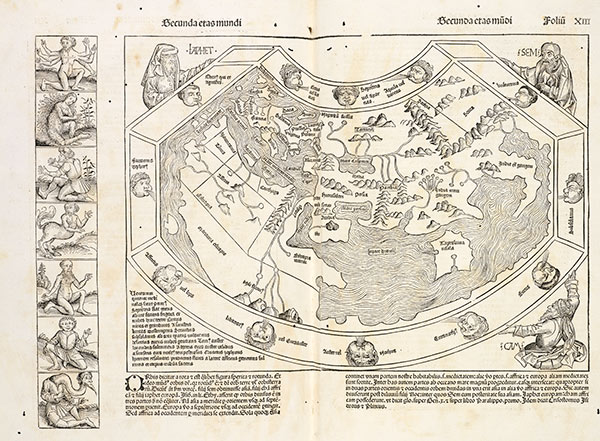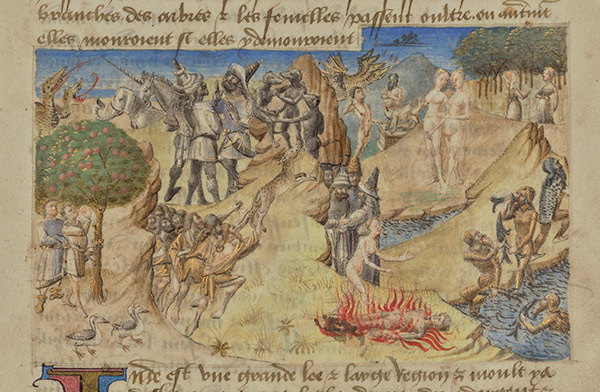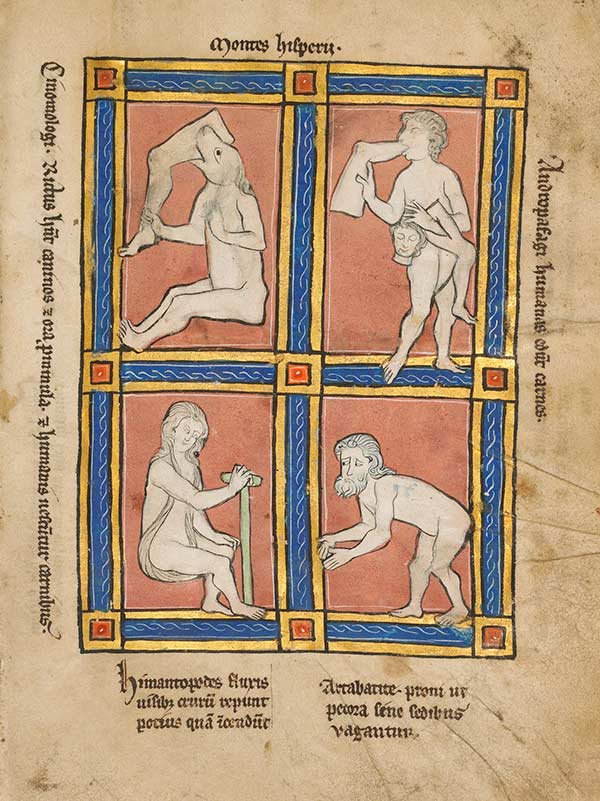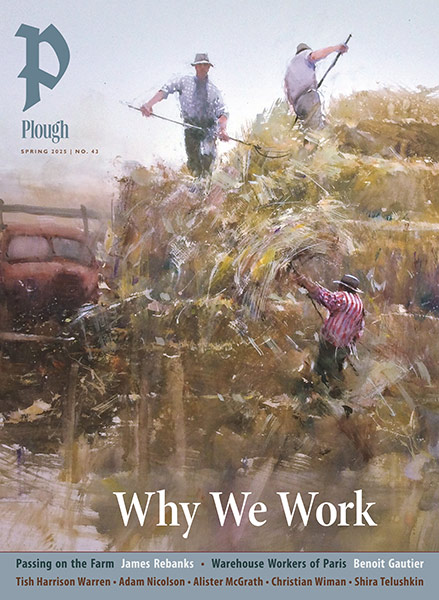Subtotal: $
Checkout
A Book of Marvels
We might not be so different from medieval artists who drew exotic creatures, places, and people they’d never seen.
By Arthur Aghajanian
August 24, 2024
Given our enchantment with the endless stream of innovations and immersive experiences offered up by the culture industry, any of us could be forgiven for believing that a simple, modest exhibition dedicated to illuminated manuscripts would be stodgy and inconsequential. Yet, in the dim glow of ancient vellum and gold leaf, timeworn treasures still have the capacity to strike a contemporary chord. On a recent visit to the Getty Center in Los Angeles, I experienced this resonance anew. In an exhibition that showcased the peculiarities of the medieval imagination, viewers were confronted with something at once outlandish and unsettlingly familiar.
The Book of Marvels: Wonder and Fear in the Middle Ages explores the Book of the Marvels of the World, an illuminated manuscript made in France that compiles tales derived from ancient sources, medieval folklore, and supposed eyewitness accounts about cultures both within and far outside of Europe. The book was originally created by an anonymous author around 1380. Only four known copies remain, all produced in the fifteenth century. Featuring illuminations by the Master of the Geneva Boccaccio, copies owned by the Getty and the Morgan Library and Museum in New York are shown side by side. They are joined in the exhibition by fourteen other illuminated manuscripts that echo the motifs of otherness found in the Book of Marvels.
Indeed, the exhibition places the theme of othering at its core. With its encyclopedic range, The Book of Marvels highlights “exotic” cultures and locales, portraying difference with an air of scientific authority. Though often fictional, these descriptions aimed to fascinate readers while reinforcing their sense of civilized superiority. Accompanying illustrations, rich in narrative detail, translate these descriptions into complex tableaux that are often grouped within a single image. Lively, striking compositions simulate a journey through fabled landscapes populated by strange creatures with bizarre customs.

Book of the Marvels of the World, Scythia, ca. 1460. Illuminated by the Master of the Geneva Boccaccio. Vellum, colored washes, gold, ink on parchment. The Morgan Library & Museum, New York. Purchased by J. Pierpont Morgan (1837–1913) in 1911. Ms. M.461, fol. 70. Photo: Janny Chiu. L.2024.1.
The two copies of the book, along with the other manuscripts in the exhibition – fanciful bestiaries, a world chronicle, a beautiful Armenian Gospel, an imaginative fifteenth-century map of the world – make it clear that xenophobia rooted in geography, race, and religion is not a new phenomenon. These works effectively demonstrate how medieval Europeans viewed a largely unknown world they found by turns threatening and fascinating. Bolstering contentment with familiar surroundings, reaffirming Eurocentric perceptions, and stoking fantasies about the savage nature of the other, these manuscripts possess layered meanings that would have elicited a variety of interpretations from their readers.
A painting of India from the Book of Marvels on display depicts a surreal landscape where oversized figures tower over a patchwork geography in an image that confounds time and space in a single, fantastical scene. Among those occupying this strange land are hybrid beings that combine human features with dogs, men with reversed feet and eight toes, and people with no mouths who live on the scents of flowers and trees. Joining them are dangerously beautiful maidens living alongside a river who have the power to coerce men into sex. Each cluster of characters, though close to others, appears to be independently contained, giving the tableau a collage-like appearance. Intermingled with these figures we find supernatural animals: a unicorn, dragons, and two-headed geese.
The image depicting Scythia, the land north of the Black Sea, is no less fantastical. An equally dense and skillfully balanced composition includes such things as human sacrifice, reversed gender roles, people who skin their fallen enemies, others who drink blood, mountain-dwelling cyclopes, griffins that guard precious emeralds, and men with horse feet. The complexity of the two images on display reflects the extensive descriptions of these two lands in the accompanying text.
Several other examples from the Getty’s collection that are included in the show are no less memorable. An illumination from a book called Wonders of the World (1277 or after) displays four fantastical beings with bizarre anatomies (Cinomologus; Anthropophagus; Himantopode; Artabatite), each enclosed within a separate frame as if in a catalog of oddities. Such groupings were a common mode of depicting legendary creatures in the Middle Ages. Anthropophagi are found in the Book of Marvels as well.

Map of the World, 1493, from the Nuremberg Chronicle. Illustrated by Michael Wolgemut and Wilhelm Pleydenwurff. Woodcut and letterpress. Getty Research Institute. 84-B7073, fols. 12v–13.
The world map from the Nuremberg Chronicle (1493) presents the world in whimsical shapes, with mythical creatures and allegorical figures adorning its margins, altogether evoking the feel of a fantasy game board. When we compare it to a contemporary map, we’re struck by how differently the world was perceived in this period and how the unknown was creatively imagined.
Medieval perceptions of foreign lands and peoples were not monolithic but varied widely, shaped by many factors. Often inconsistent, they reflected a complex interplay of religious, cultural, and political influences. Over time, as Europeans traveled more, whether for pilgrimage, trade, diplomacy, personal adventure, exploration, or the pursuit of knowledge, they developed a range of perspectives. Yet their understanding of the other, while gaining nuance over time, was still framed by a worldview that struggled to reconcile strongly held beliefs with empirical observation.
This realization leads to important theological considerations. The Book of Marvels documents the reaction of a Christian society that, driven by advances in technology, is attempting to reorient itself in relation to the divine order in light of the vast new world beyond its frontier. During an era of increased cultural exchange, European Christians began to sense the enormity of the world and the modest place they occupied within it. Their encounters led them to reevaluate their relationship to God and the immensity of his creation. Inevitably, their quest to impose order and make sense of their discoveries led medieval authors, scribes, and illuminators to fill gaps in their knowledge with beliefs and concepts to produce a coherent picture of their new reality. Grappling with the unknown, their imaginations exaggerated differences, which reinforced group identity while creating absurdly distorted images of those seen as different. Thinking back on the exhibition, I was reminded of the title of Francisco Goya’s famous eighteenth-century print, The Sleep of Reason Produces Monsters. Strange beings are also born when one group projects its anxieties and fears onto another.
Doesn’t this tendency seem familiar? In fact, I can’t think of any more apt reflection of our current societal condition.
Living in a digital age, we too have experienced a widening of our world that often challenges us to rethink our place in God’s creation. Like the citizens of medieval Europe, we frequently succumb to the illusions that accompany advances in technology. With immediate access to vast information, we tend to overestimate our grasp of the world. Much like the medieval armchair travelers who comfortably perused the Book of Marvels and believed they understood a world outside their immediate experience, we consume information about distant people, places, and events, attempt to fit them neatly into our conceptual framework, and react accordingly. The ease of access to information often leads to shallow understanding rather than deep insight. Social media further complicates this by creating echo chambers that reinforce existing beliefs and distort reality through sensationalism. Think about how many memes a day we see that portray political adversaries as monstrous.
A personal conceptual framework, shaped by our experiences, biases, and cultural context, inherently limits our understanding of the world. It filters and interprets information based on preexisting notions, which can lead to a narrow or distorted view of reality. Our framework can prevent us from fully appreciating the complexity and diversity of the world around us, as we tend to fit new information into familiar categories, potentially missing deeper insights and alternative perspectives.

Book of the Marvels of the World, India, detail, ca.1460–65. Illuminated by the Master of the Geneva Boccaccio. Colored washes, gold, and ink on parchment. Getty Museum. Ms. 124 (2022.15), fol. 5.
It’s not easy for us to acknowledge how much we don’t know about the world. But recognizing that there are aspects of existence beyond our comprehension cultivates humility and openness. It allows us to appreciate the wonder and complexity of God’s creation without the need to reduce it to simplistic explanations. Being receptive to mystery, remaining curious, questioning our assumptions, and seeking wisdom from sources beyond our immediate grasp are all ways to honor the vastness of creation with greater spiritual maturity.
Here we may draw upon the principle of imago Dei, that all people are created in the image of God, which emphasizes our interconnectedness. Recognizing that we share God’s image with all people deepens our sense of unity and can aid us in overcoming the most harmful kinds of cultural division. Considering the historical context of the Book of Marvels, it’s evident that in the Middle Ages, when the church wielded significant political power and influence, it often failed to align its practices with this foundational belief.
The imago Dei precludes othering by clarifying our shared nature. In the fourth century, Gregory of Nyssa’s interpretation emphasized both the vertical perspective: the relationship between human beings and God, and the horizontal perspective: the relationship between all people. In our own time, the German theologian Jürgen Moltmann articulated how this principle should guide political and social relations, and extended it to environmental stewardship. Embracing imago Dei in this inclusive and relational way reaffirms the inherent worth of all people and leads to a more compassionate worldview.
Thus, the Getty exhibition does more than reveal a history of othering and its typologies. It highlights our current challenges and provides a vantage point from which we can more clearly observe and understand the dynamics of our own era. And, as an exhibition centered on texts produced in the context of European Christianity, it invites a theological perspective on our societal malaise. Virtual travel guides that whisked their users far beyond home, which in their time reinforced biases and shaped perceptions of distant locales, can help us today. They bring into focus how digital cultures similarly build a reality around ideological constructs, sensationalist narratives, and fear-driven tactics. We may not be medieval, but our screens often confine us to a narrow worldview while amplifying our dread of the many things we perceive as threats.
The visual stimuli of our digital culture don’t just shape our perceptions; they become our reality. French philosopher Jean Baudrillard argued decades ago that the erasure of the boundary between reality and simulation replaces authentic experience with the hyperreality of images. Unlike the Middle Ages, today images are omnipresent and democratized, saturating our daily lives, influencing our thoughts and behaviors and how we treat others. To escape this trap and move beyond the confines of the simulation, we must become more critically aware of the images that permeate our environment. This involves questioning the narratives they present, which requires media literacy. But it’s also important to seek out authentic experiences and practices beyond the digital realm to reconnect with the tangible and the real.
The Getty’s exhibition, then, not only perceptively frames our predicament but simultaneously presents a remedy for our digital saturation. We recognize our unity with the creators of these manuscripts when we relate to their creativity, feel it mirrored in ourselves, and consider how all of this reflects the divine. That is, in the act of contemplating the manuscripts, attracted by their material presence, we recognize a shared essence between ourselves and their creators.
We must remember that medieval artists used illuminated manuscripts not just as a means of expression but as a form of spiritual devotion. For us too, the close study of illuminated manuscripts can promote contemplation. Their extraordinary material features set them apart from the commonplace objects we encounter daily.
Exhibitions of illuminated manuscripts can replicate the intimate, personal quality these books had for their original owners. Their rarity and fragility inspire us to slow down and focus on what the pages offer. The texture of vellum or parchment, the play of light on gold, and the delicate craftsmanship encourage a meditative interaction, heightening awareness of both the artistry and the significance of these historical treasures. Unlike the fleeting, often overwhelming stimuli of digital screens, manuscripts require attentive viewing. They draw us in, causing us to become absorbed in their intricate designs and elegant lettering, offering relief from the incessant distractions of the digital world.

Wonders of the World, Cinomologus; Anthropophagus; Himantopode; Artabatite, ca. 1277. Franco-Flemish. Tempera colors, pen and ink, gold leaf, and gold paint on parchment. Getty Museum. Ms. Ludwig XV 4 (83.MR.174), fol. 117.
Certainly, the manner of presentation plays a role in enabling such a meditative response. Curatorial choices at the Getty, such as wall color, placement of display cases, and careful lighting, encourage viewers to closely observe the minute details of the manuscripts. Moving through the hushed, intimate space of the gallery, we are invited to engage with the books in a manner that honors their physical dimensions. The spatial arrangement encourages one to compare and contrast the various kinds of manuscript, both religious and secular. When navigating the displays, nuances in style, varieties in compositional format, the relationship between text and image, and crucial details gradually come into focus.
Touchscreen displays adjacent to the two copies of the Book of Marvels identified the characters inhabiting the images of India and Scythia in the pages on exhibit. The low-resolution images actually led me to appreciate the illuminations even more. The bold and vivid compositions are a result of the “colored grisaille” technique, characterized by its crisp, defined edges and vibrant, layered hues. In both paintings, narrative elements are conveyed with precise attention to textures, facial expressions, gestures, and settings. All of this is brought to life through subtle tones and striking contrasts of color. In comparison, the digital images on the interactive tables were flat, blurred, and muddy. Yet, in prompting me to examine details in the illuminations more closely, this minimal digital component enhanced my viewing experience. Providing valuable information in a simple, unobtrusive way, the interactive component was a notable example of how to successfully apply current technology in a museum setting.
The skilled craftsmanship and collaborative efforts behind illuminated manuscripts are evident in the merging of image and text. These manuscripts were created through the combined efforts of scribes, artists, and patrons, an example of how material culture enriches community and spirituality. In medieval times, illuminated manuscripts would pass through many hands. Many bear visible traces of their use, and include specific prayers, family crests, or dedications, identifying them as unique and treasured possessions. Relating to the communal settings of monasteries and churches, religious illuminated manuscripts were designed not only for personal devotion but also for use in collective worship. They provide a link to our religious and artistic heritage and the broader community of believers throughout history.
Although the Book of the Marvels of the World isn’t a religious text, its inclusion amongst a group of Christian manuscripts points to how medieval experiences of the other were understood in the context of perspectives on the divine order. The handmade beauty of the illuminated manuscript invites us to return to a more contemplative and creative mode of experiencing our own world.
Already a subscriber? Sign in
Try 3 months of unlimited access. Start your FREE TRIAL today. Cancel anytime.






